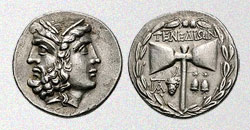A key component of leadership

A major challenge all managers face is how to motivate their employees to do the best job they can. This is problematic because – despite the usual corporate values of “we respect our employees” and “open door policy” – there is always an element of mistrust between management and employees (I discuss it in the context of Information Overload in this article); and mistrust is a major demotivator. So, managers need to assure employees that they are sincere in what they tell them – and, until someone invents a mind reading device, this is tough.
Of course this is where Leadership comes in: a good leader has their followers’ trust. And one excellent way to attain this trust is by putting your money where your mouth is.
How this works
“Put your money where your mouth is”, or “Pay up or shut up”, sound like expressions preceding a saloon brawl in a Western movie; but they have great relevance in the workplace. And I mean real money; “Walk the Talk” aims at the same result but is far less effective. The manager needs to be seen spending the cash!
For example: you are a manager in a production line and you’ve endlessly exhorted the line operators that “Quality is Job One”. Then some mishap causes a production lot to fall marginally outside the specifications. What do you do?
Now, employees, I used to say in my days as Quality Assurance manager, have a magnetic gizmo in their brain that can sense disingenuous double messages from a mile away. If you bend over backwards to issue a “waiver” and send the lot out, your subordinates will never again trust your “Job 1” assertion. If, on the other hand, you scrap the costly lot, you send a powerful message that you really mean it about Quality.
An example: Effective meetings
Ineffective meetings are a very common and destructive problem, and many a company show posters in meeting rooms listing good meeting practices. This can work well in the context of a wider program – attendees need to believe their organization means what the poster says.
But I’ve seen one company that actually brought in an excellent meeting coach that spent a year training all employees in effective meeting practices. This was done in small groups, with each group spending three days in an off-site workshop. This worked wonders not only because the training was thorough, but also because management’s willingness to invest so much time and money in this training left no doubts that they really mean business!
An example: Quality audit
I once had the occasion to observe a quality audit by an external auditor. The auditor spent two days doing the rounds, and ended with a long list of issues by the time he had to leave; he had no time left to look for more issues. When the manager of the unit being audited heard this, he immediately told the auditor he will pay the added expenses required to extend his stay, so that all the problems can be discovered. The manager was willing to spend money in order to have his unit’s failings discovered! Here, too, the message to his group was loud and clear. By the next audit, they had no problems.
An example: Training and Travel
An area where money is easily denied is travel and training (as I noted elsewhere). I once had a manager who felt strongly that his subordinates need to be trained and developed. At one point I had to travel to the US for a conference; he suggested I also attend a second conference – held in another part of the country – that would do me good professionally. I pointed out that the two were almost overlapping; I could at most attend half of the second conference. Would it be worth the extra travel expenses? The boss said, sure – I’d still learn something. I sure did learn – both at the conference, and in respecting the importance of my training in my boss’s eyes.
Bottom line
The urge to conserve money is powerful. Sometimes this is okay; at other times it can undermine trust and demotivate employees.
Know the difference!
Image courtesy Exekias, via Wikimedia Commons.
Related Posts
Why Business Travel Freezes are Bad for Your Business

